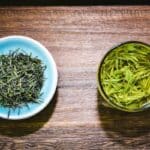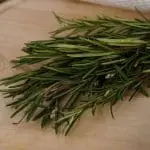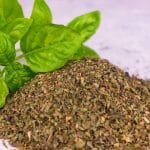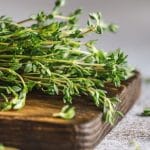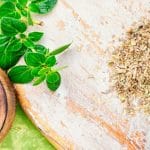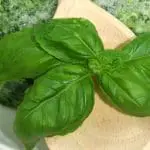Quick summary: Best alternative to bay leaves are thyme, oregano, basil, rosemary, and other aromatic herbs that can improve your dish.
Bay leaves are incredibly fragrant and used in a variety of dishes worldwide. From curries, stews, and soups to braises, pickling, and pate, they are combined with other spices to complete a hearty taste profile.
Whether you don’t have any on hand or aren’t a fan of the strong herbal scent, we recommend substituting the herb instead of leaving it out of the dish entirely.
This guide to the best bay leaf substitutes will help you choose the perfect match according to the type of herb required in your recipe and the dish you are making.
What Is a Bay Leaf?
Although actually a herb, fresh bay leaves are used as a spice in cooking. They come from the evergreen bay laurel tree and feature a unique taste that resembles a mix of mint, thyme, oregano, and hints of pepper, coriander, and clove.
The trees are mostly grown in warm Mediterranean regions and the leaves are thick and leathery compared to most other delicate herbs. Their scent is somewhat stronger than their complex flavor.
Bay laurel leaf is available ground into a powder, crushed, or in its fresh form. Whole dried laurel leaves are generally added to slow-cooked dishes to infuse flavor. When used this way, they should always be removed before serving.
There are a variety of bay leaves available, each with a slightly different appearance and flavor. The type you are most familiar with may depend on where you live or the type of cuisine you cook.
Types of Bay Leaves
The herb is commonly used to flavor stews, soups, braises, and meat dishes and is best used in its dried form.
The two main types for culinary use are Turkish bay leaf and California bay leaf. Turkish bay leaves are slightly more subtle and have a shorter and fatter shape compared to the longer and thinner shape of California bay leaves.
The California variety features a stronger mint undertone and can be overpowering in its fresh form. It is also known as California laurel, pepperwood, or Oregon myrtle.
Indian bay leaf is another variety that has an olive green color with a slight cinnamon undertone. These are popularly used in garam masala spice blends, biryani, meat preparations, curry, and biryani.
Indonesian and West Indian bay leaf are two other varieties that are most commonly used in Indonesian and Caribbean cuisine respectively.
How to Use a Bay Leaf Replacement
The replacement you choose will depend on the type of dish you are cooking and the herb variety called for in the recipe.
When cooking Indian recipes, you want to use the Indian variety as opposed to laurel leaves since the flavor is quite different. This means using cassia, cinnamon, or a clove blend may be a better substitute than something like thyme or oregano which won’t match the flavor profile.
One fresh bay leaf is equal to two dried leaves. If your recipe calls for a whole dried leaf and you only have crushed bay leaf, use ¼ teaspoon crushed bay leaf instead.
If you are feeling a little uncertain about how to choose the best bay leaf alternative, don’t worry. This guide will help you choose the best substitute step-by-step according to the specific cuisine you are cooking.
Best Bay Leaf Substitutes
Thyme
Since bay leaves are removed from dishes before serving they aren’t used for visual appeal. Therefore, the look of the substitute you choose isn’t of much significance. Just as well, because thyme doesn’t look anything like laurel bay leaf.
Thyme is an evergreen herb from the mint family. It has small green leaves and can be used dried or fresh. The pronounced herbal flavor has woody and floral undertones and is popularly used in French and Italian dishes. It is not suitable for use in Indian recipes.
You can dry fresh thyme and prepare your own stocks for later.
Substitute Quantity: Replace one dried bay leaf with ¼ teaspoon dried thyme
Best for: Pork, poultry, roast chicken, lamb, beef, stews, vegetables, soup, and fish dishes
Oregano
Oregano is another Mediterranean herb that is pretty easy to find at most grocery stores and is popular in Italian cuisine. It is also part of the mint family and has a wonderful earthy flavor, bitter and peppery undertones, and a touch of sweetness.
Substitute Quantity: For every one laurel leaf, use only ¼ teaspoon of dried oregano
Best for: Meat, poultry, tomato-centric sauces, stews, and vegetable dishes
Read valuable tips on how to dry oregano leaves to preserve them for later.
Mexican Oregano
Mexican oregano is from a different plant family and although it has similar flavor notes it has a citrus undertone rather than the minty flavor of Mediterranean oregano. It is generally found in Latin America or as a dried herb in some US grocery stores.
Substitute Quantity: Use ¼ teaspoon Mexican oregano to replace 1 bay leaf
Best for: Meat dishes, beans, and chili
Basil
Basil is another popular Italian herb and that means that it’s mostly suitable as a replacement in Italian-style and Mediterranean cooking. As with the above options, it is not a suitable replacement in Indian cooking.
Fresh basil has large tender green leaves with mint, anise, and pepper undertones. It brings a wonderful herbaceousness to dishes. Basil is popular to use in its fresh form, but it is also available dried and crushed.
When working out your substitution quantity, note that one teaspoon of dried basil is equivalent to four to eight fresh basil leaves.
Substitute Quantity: Use basil in equal quantities as a replacement
Best for: Tomato-based dishes, salads, poultry, roast chicken, lamb, beef, stews, vegetables, and fish dishes
Basil is suitable for cold storage, so here’s how to freeze basil and have it for future cooking.
Boldo Leaves
Boldo leaves are another South American herb. Their flavor is reminiscent of bay leaves with some bitterness. The flavor is pretty strong, so use a little less than called for in your recipe to avoid overpowering your dish.
Substitute Quantity: Use only half the amount called for in your recipe. If your recipe requires two dried bay leaves, use only one boldo leaf.
Best for: Sauces and savory dishes that include fish, vegetables, and mushrooms.
Juniper Berries
Although juniper berries look like berries they aren’t true berries. They come from a juniper tree and have a bitter, slightly piney, and peppery flavor.
Besides being used in cooking they are well known for their beneficial health properties. They are however not recommended for pregnant women.
Substitute Quantity: Use ¼ teaspoon juniper berries as a replacement for a single bay leaf
Best for: Marinades, meat rubs, duck, wild game dishes, and pickling meats
Rosemary
Rosemary does not have a similar flavor, however, it pairs well with a variety of ingredients and is part of the mint family with basil, thyme, and oregano. It is a woody herb with a pine-like flavor and thin, hardy, needle-shaped leaves. Rosemary can be used fresh or as dried leaves.
As with thyme, you can add the whole stem to your recipe when cooking to impart flavor, however, you need to remove it before serving. It is best added at the beginning of cooking time to release the oils and flavor.
Substitute Quantity: Use rosemary in equal quantities as a replacement
Best for: Meat dishes including beef and lamb recipes, pork, goat, chicken, and turkey, as well as potato dishes, root vegetables, stews, and barbecues.
Learn how to dry fresh rosemary to keep it for more extended storage.
Best Substitutes for Indian Bay Leaf
The Indian variety, also known as Tej Patta, has a different taste to laurel bay leaves and is generally only used in Indian cuisine. That is why the Mediterranean-style herbs above won’t be a suitable match as a substitute.
If you don’t have Indian bay leaves on hand, you can add a few cloves, cassia, cinnamon, or use curry leaves instead. Remember to strain out any whole spices such as cloves, curry leaves, or cinnamon sticks before serving your dish. Cloves are very strong so use them sparingly.
FAQ
Yes, you can use red bay leaves in equal quantities as a successful substitute.
Sage is not a great replacement. You’re better off choosing one of the above alternatives or leaving it out of your recipe.
Yes, the leaves can be steeped in hot water to make tea. The tea is known to have a range of health benefits including heart health and lowering blood pressure.
Conclusion
Bay leaves come in different varieties each with unique flavor characteristics. This can make it somewhat confusing when choosing a substitute for your dish.
When cooking Western and European-style dishes, thyme, oregano, and basil can all be used successfully as substitutes. In Mexican or Latin recipes, opt for boldo or Mexican oregano.
When cooking Indian-style curries your best bet is to go with curry leaves, a touch of cinnamon, or clove.
Always remember to remove whole dried leaves, whole spices, or herbs on the stem before serving your dish as biting into one of these will most likely ruin your meal.
*image by Nikolay_Donetsk/depositphotos


